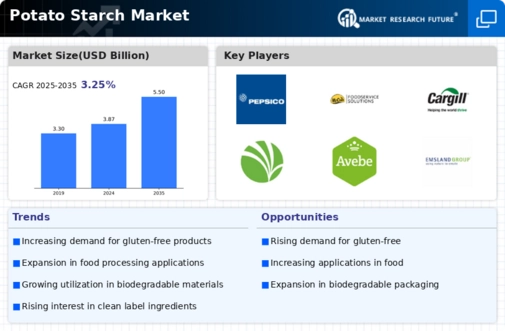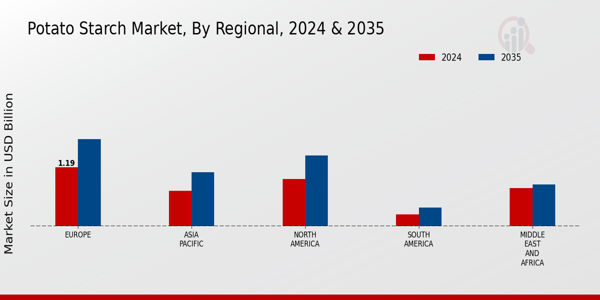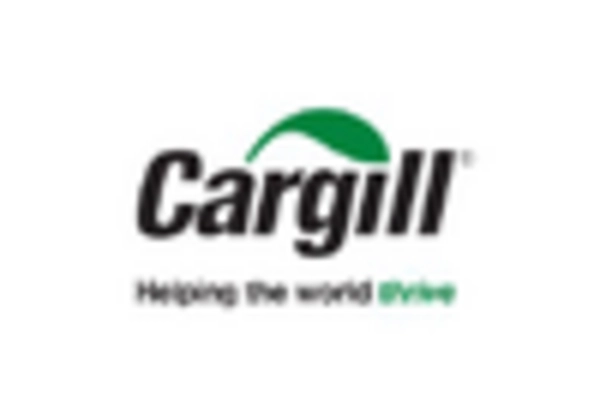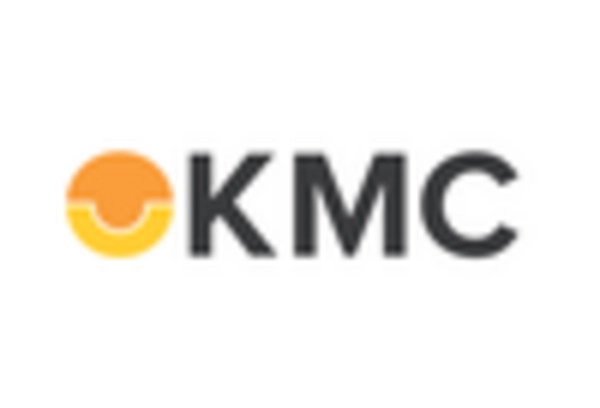-
FACTOR ANALYSIS
-
\r\n\r\n\r\nValue chain Analysis
-
\r\n\r\n\r\nPorter's
-
Five Forces Analysis
-
\r\n\r\n\r\nBargaining Power of Suppliers
-
\r\n\r\n\r\nBargaining
-
Power of Buyers
-
\r\n\r\n\r\nThreat of New Entrants
-
\r\n\r\n\r\nThreat
-
of Substitutes
-
\r\n\r\n\r\nIntensity of Rivalry
-
\r\n\r\n\r\n\r\n\r\nCOVID-19
-
Impact Analysis
-
\r\n\r\n\r\nMarket Impact Analysis
-
\r\n\r\n\r\nRegional
-
Impact
-
\r\n\r\n\r\nOpportunity and Threat Analysis
-
\r\n\r\n\r\n\r\n\r\n\r\n\r\n\r\n\r\nPotato
-
Starch Market, BY Application (USD Billion)
-
\r\n\r\n\r\nFood
-
and Beverage
-
\r\n\r\n\r\nTextile
-
\r\n\r\n\r\nPaper
-
\r\n\r\n\r\nPharmaceutical
-
\r\n\r\n\r\nCosmetics
-
\r\n\r\n\r\n\r\n\r\nPotato
-
Starch Market, BY End Use (USD Billion)
-
\r\n\r\n\r\nFood
-
Processors
-
\r\n\r\n\r\nBeverage Manufacturers
-
\r\n\r\n\r\nCosmetic
-
Manufacturers
-
\r\n\r\n\r\nPharmaceutical Companies
-
\r\n\r\n\r\n\r\n\r\nPotato
-
Starch Market, BY Type (USD Billion)
-
\r\n\r\n\r\nNative
-
Starch
-
\r\n\r\n\r\nModified Starch
-
\r\n\r\n\r\nInstant
-
Starch
-
\r\n\r\n\r\nPre-gelatinized Starch
-
\r\n\r\n\r\n\r\n\r\nPotato
-
Starch Market, BY Source (USD Billion)
-
\r\n\r\n\r\nPotatoes
-
\r\n\r\n\r\nCassava
-
\r\n\r\n\r\nCorn
-
\r\n\r\n\r\nWheat
-
\r\n\r\n\r\n\r\n\r\nPotato
-
Starch Market, BY Regional (USD Billion)
-
\r\n\r\n\r\nNorth
-
America
-
\r\n\r\n\r\nUS
-
\r\n\r\n\r\nCanada
-
\r\n\r\n\r\n\r\n\r\nEurope
-
\r\n\r\n\r\nGermany
-
\r\n\r\n\r\nUK
-
\r\n\r\n\r\nFrance
-
\r\n\r\n\r\nRussia
-
\r\n\r\n\r\nItaly
-
\r\n\r\n\r\nSpain
-
\r\n\r\n\r\nRest
-
of Europe
-
\r\n\r\n\r\n\r\n\r\nAPAC
-
\r\n\r\n\r\nChina
-
\r\n\r\n\r\nIndia
-
\r\n\r\n\r\nJapan
-
\r\n\r\n\r\nSouth
-
Korea
-
\r\n\r\n\r\nMalaysia
-
\r\n\r\n\r\nThailand
-
\r\n\r\n\r\nIndonesia
-
\r\n\r\n\r\nRest
-
of APAC
-
\r\n\r\n\r\n\r\n\r\nSouth America
-
\r\n\r\n\r\nBrazil
-
\r\n\r\n\r\nMexico
-
\r\n\r\n\r\nArgentina
-
\r\n\r\n\r\nRest
-
of South America
-
\r\n\r\n\r\n\r\n\r\nMEA
-
\r\n\r\n\r\nGCC
-
Countries
-
\r\n\r\n\r\nSouth Africa
-
\r\n\r\n\r\nRest
-
of MEA
-
\r\n\r\n\r\n\r\n\r\n\r\n\r\n\r\n\r\nCompetitive
-
Landscape
-
\r\n\r\n\r\nOverview
-
\r\n\r\n\r\nCompetitive
-
Analysis
-
\r\n\r\n\r\nMarket share Analysis
-
\r\n\r\n\r\nMajor
-
Growth Strategy in the Potato Starch Market
-
\r\n\r\n\r\nCompetitive
-
Benchmarking
-
\r\n\r\n\r\nLeading Players in Terms of Number of Developments
-
in the Potato Starch Market
-
\r\n\r\n\r\nKey developments and growth
-
strategies
-
\r\n\r\n\r\nNew Product Launch/Service Deployment
-
\r\n\r\n\r\nMerger
-
& Acquisitions
-
\r\n\r\n\r\nJoint Ventures
-
\r\n\r\n\r\n\r\n\r\nMajor
-
Players Financial Matrix
-
\r\n\r\n\r\nSales and Operating Income
-
\r\n\r\n\r\nMajor
-
Players R&D Expenditure. 2023
-
\r\n\r\n\r\n\r\n\r\n\r\n\r\nCompany
-
Profiles
-
\r\n\r\n\r\nAvebe
-
\r\n\r\n\r\nFinancial
-
Overview
-
\r\n\r\n\r\nProducts Offered
-
\r\n\r\n\r\nKey
-
Developments
-
\r\n\r\n\r\nSWOT Analysis
-
\r\n\r\n\r\nKey
-
Strategies
-
\r\n\r\n\r\n\r\n\r\nCargill
-
\r\n\r\n\r\nFinancial
-
Overview
-
\r\n\r\n\r\nProducts Offered
-
\r\n\r\n\r\nKey
-
Developments
-
\r\n\r\n\r\nSWOT Analysis
-
\r\n\r\n\r\nKey
-
Strategies
-
\r\n\r\n\r\n\r\n\r\nNovidon Starch
-
\r\n\r\n\r\nFinancial
-
Overview
-
\r\n\r\n\r\nProducts Offered
-
\r\n\r\n\r\nKey
-
Developments
-
\r\n\r\n\r\nSWOT Analysis
-
\r\n\r\n\r\nKey
-
Strategies
-
\r\n\r\n\r\n\r\n\r\nPepsiCo
-
\r\n\r\n\r\nFinancial
-
Overview
-
\r\n\r\n\r\nProducts Offered
-
\r\n\r\n\r\nKey
-
Developments
-
\r\n\r\n\r\nSWOT Analysis
-
\r\n\r\n\r\nKey
-
Strategies
-
\r\n\r\n\r\n\r\n\r\nKMC Kartoffelmelcentralen
-
\r\n\r\n\r\nFinancial
-
Overview
-
\r\n\r\n\r\nProducts Offered
-
\r\n\r\n\r\nKey
-
Developments
-
\r\n\r\n\r\nSWOT Analysis
-
\r\n\r\n\r\nKey
-
Strategies
-
\r\n\r\n\r\n\r\n\r\nIngredion
-
\r\n\r\n\r\nFinancial
-
Overview
-
\r\n\r\n\r\nProducts Offered
-
\r\n\r\n\r\nKey
-
Developments
-
\r\n\r\n\r\nSWOT Analysis
-
\r\n\r\n\r\nKey
-
Strategies
-
\r\n\r\n\r\n\r\n\r\nMGP Ingredients
-
\r\n\r\n\r\nFinancial
-
Overview
-
\r\n\r\n\r\nProducts Offered
-
\r\n\r\n\r\nKey
-
Developments
-
\r\n\r\n\r\nSWOT Analysis
-
\r\n\r\n\r\nKey
-
Strategies
-
\r\n\r\n\r\n\r\n\r\nAustrian Potato Industry
-
\r\n\r\n\r\nFinancial
-
Overview
-
\r\n\r\n\r\nProducts Offered
-
\r\n\r\n\r\nKey
-
Developments
-
\r\n\r\n\r\nSWOT Analysis
-
\r\n\r\n\r\nKey
-
Strategies
-
\r\n\r\n\r\n\r\n\r\nEmsland Group
-
\r\n\r\n\r\nFinancial
-
Overview
-
\r\n\r\n\r\nProducts Offered
-
\r\n\r\n\r\nKey
-
Developments
-
\r\n\r\n\r\nSWOT Analysis
-
\r\n\r\n\r\nKey
-
Strategies
-
\r\n\r\n\r\n\r\n\r\nTate and Lyle
-
\r\n\r\n\r\nFinancial
-
Overview
-
\r\n\r\n\r\nProducts Offered
-
\r\n\r\n\r\nKey
-
Developments
-
\r\n\r\n\r\nSWOT Analysis
-
\r\n\r\n\r\nKey
-
Strategies
-
\r\n\r\n\r\n\r\n\r\nStarch Europe
-
\r\n\r\n\r\nFinancial
-
Overview
-
\r\n\r\n\r\nProducts Offered
-
\r\n\r\n\r\nKey
-
Developments
-
\r\n\r\n\r\nSWOT Analysis
-
\r\n\r\n\r\nKey
-
Strategies
-
\r\n\r\n\r\n\r\n\r\nKraft Foods
-
\r\n\r\n\r\nFinancial
-
Overview
-
\r\n\r\n\r\nProducts Offered
-
\r\n\r\n\r\nKey
-
Developments
-
\r\n\r\n\r\nSWOT Analysis
-
\r\n\r\n\r\nKey
-
Strategies
-
\r\n\r\n\r\n\r\n\r\nAmerican Key Food Products
-
\r\n\r\n\r\nFinancial
-
Overview
-
\r\n\r\n\r\nProducts Offered
-
\r\n\r\n\r\nKey
-
Developments
-
\r\n\r\n\r\nSWOT Analysis
-
\r\n\r\n\r\nKey
-
Strategies
-
\r\n\r\n\r\n\r\n\r\n\r\n\r\nAppendix
-
\r\n\r\n\r\nReferences
-
\r\n\r\n\r\nRelated
-
Reports
-
\r\n\r\n\r\n\r\n\r\nLIST Of tables
-
\r\n
-
\r\n\r\n\r\nLIST
-
OF ASSUMPTIONS
-
\r\n\r\n\r\nNorth America Potato Starch Market SIZE
-
ESTIMATES & FORECAST, BY APPLICATION, 2019-2035 (USD Billions)
-
\r\n\r\n\r\nNorth
-
America Potato Starch Market SIZE ESTIMATES & FORECAST, BY END USE, 2019-2035
-
(USD Billions)
-
\r\n\r\n\r\nNorth America Potato Starch Market SIZE
-
ESTIMATES & FORECAST, BY TYPE, 2019-2035 (USD Billions)
-
\r\n\r\n\r\nNorth
-
America Potato Starch Market SIZE ESTIMATES & FORECAST, BY SOURCE, 2019-2035
-
(USD Billions)
-
\r\n\r\n\r\nNorth America Potato Starch Market SIZE
-
ESTIMATES & FORECAST, BY REGIONAL, 2019-2035 (USD Billions)
-
\r\n\r\n\r\nUS
-
Potato Starch Market SIZE ESTIMATES & FORECAST, BY APPLICATION, 2019-2035 (USD
-
Billions)
-
\r\n\r\n\r\nUS Potato Starch Market SIZE ESTIMATES &
-
FORECAST, BY END USE, 2019-2035 (USD Billions)
-
\r\n\r\n\r\nUS Potato
-
Starch Market SIZE ESTIMATES & FORECAST, BY TYPE, 2019-2035 (USD Billions)
-
\r\n\r\n\r\nUS
-
Potato Starch Market SIZE ESTIMATES & FORECAST, BY SOURCE, 2019-2035 (USD Billions)
-
\r\n\r\n\r\nUS
-
Potato Starch Market SIZE ESTIMATES & FORECAST, BY REGIONAL, 2019-2035 (USD
-
Billions)
-
\r\n\r\n\r\nCanada Potato Starch Market SIZE ESTIMATES
-
& FORECAST, BY APPLICATION, 2019-2035 (USD Billions)
-
\r\n\r\n\r\nCanada
-
Potato Starch Market SIZE ESTIMATES & FORECAST, BY END USE, 2019-2035 (USD Billions)
-
\r\n\r\n\r\nCanada
-
Potato Starch Market SIZE ESTIMATES & FORECAST, BY TYPE, 2019-2035 (USD Billions)
-
\r\n\r\n\r\nCanada
-
Potato Starch Market SIZE ESTIMATES & FORECAST, BY SOURCE, 2019-2035 (USD Billions)
-
\r\n\r\n\r\nCanada
-
Potato Starch Market SIZE ESTIMATES & FORECAST, BY REGIONAL, 2019-2035 (USD
-
Billions)
-
\r\n\r\n\r\nEurope Potato Starch Market SIZE ESTIMATES
-
& FORECAST, BY APPLICATION, 2019-2035 (USD Billions)
-
\r\n\r\n\r\nEurope
-
Potato Starch Market SIZE ESTIMATES & FORECAST, BY END USE, 2019-2035 (USD Billions)
-
\r\n\r\n\r\nEurope
-
Potato Starch Market SIZE ESTIMATES & FORECAST, BY TYPE, 2019-2035 (USD Billions)
-
\r\n\r\n\r\nEurope
-
Potato Starch Market SIZE ESTIMATES & FORECAST, BY SOURCE, 2019-2035 (USD Billions)
-
\r\n\r\n\r\nEurope
-
Potato Starch Market SIZE ESTIMATES & FORECAST, BY REGIONAL, 2019-2035 (USD
-
Billions)
-
\r\n\r\n\r\nGermany Potato Starch Market SIZE ESTIMATES
-
& FORECAST, BY APPLICATION, 2019-2035 (USD Billions)
-
\r\n\r\n\r\nGermany
-
Potato Starch Market SIZE ESTIMATES & FORECAST, BY END USE, 2019-2035 (USD Billions)
-
\r\n\r\n\r\nGermany
-
Potato Starch Market SIZE ESTIMATES & FORECAST, BY TYPE, 2019-2035 (USD Billions)
-
\r\n\r\n\r\nGermany
-
Potato Starch Market SIZE ESTIMATES & FORECAST, BY SOURCE, 2019-2035 (USD Billions)
-
\r\n\r\n\r\nGermany
-
Potato Starch Market SIZE ESTIMATES & FORECAST, BY REGIONAL, 2019-2035 (USD
-
Billions)
-
\r\n\r\n\r\nUK Potato Starch Market SIZE ESTIMATES &
-
FORECAST, BY APPLICATION, 2019-2035 (USD Billions)
-
\r\n\r\n\r\nUK
-
Potato Starch Market SIZE ESTIMATES & FORECAST, BY END USE, 2019-2035 (USD Billions)
-
\r\n\r\n\r\nUK
-
Potato Starch Market SIZE ESTIMATES & FORECAST, BY TYPE, 2019-2035 (USD Billions)
-
\r\n\r\n\r\nUK
-
Potato Starch Market SIZE ESTIMATES & FORECAST, BY SOURCE, 2019-2035 (USD Billions)
-
\r\n\r\n\r\nUK
-
Potato Starch Market SIZE ESTIMATES & FORECAST, BY REGIONAL, 2019-2035 (USD
-
Billions)
-
\r\n\r\n\r\nFrance Potato Starch Market SIZE ESTIMATES
-
& FORECAST, BY APPLICATION, 2019-2035 (USD Billions)
-
\r\n\r\n\r\nFrance
-
Potato Starch Market SIZE ESTIMATES & FORECAST, BY END USE, 2019-2035 (USD Billions)
-
\r\n\r\n\r\nFrance
-
Potato Starch Market SIZE ESTIMATES & FORECAST, BY TYPE, 2019-2035 (USD Billions)
-
\r\n\r\n\r\nFrance
-
Potato Starch Market SIZE ESTIMATES & FORECAST, BY SOURCE, 2019-2035 (USD Billions)
-
\r\n\r\n\r\nFrance
-
Potato Starch Market SIZE ESTIMATES & FORECAST, BY REGIONAL, 2019-2035 (USD
-
Billions)
-
\r\n\r\n\r\nRussia Potato Starch Market SIZE ESTIMATES
-
& FORECAST, BY APPLICATION, 2019-2035 (USD Billions)
-
\r\n\r\n\r\nRussia
-
Potato Starch Market SIZE ESTIMATES & FORECAST, BY END USE, 2019-2035 (USD Billions)
-
\r\n\r\n\r\nRussia
-
Potato Starch Market SIZE ESTIMATES & FORECAST, BY TYPE, 2019-2035 (USD Billions)
-
\r\n\r\n\r\nRussia
-
Potato Starch Market SIZE ESTIMATES & FORECAST, BY SOURCE, 2019-2035 (USD Billions)
-
\r\n\r\n\r\nRussia
-
Potato Starch Market SIZE ESTIMATES & FORECAST, BY REGIONAL, 2019-2035 (USD
-
Billions)
-
\r\n\r\n\r\nItaly Potato Starch Market SIZE ESTIMATES &
-
FORECAST, BY APPLICATION, 2019-2035 (USD Billions)
-
\r\n\r\n\r\nItaly
-
Potato Starch Market SIZE ESTIMATES & FORECAST, BY END USE, 2019-2035 (USD Billions)
-
\r\n\r\n\r\nItaly
-
Potato Starch Market SIZE ESTIMATES & FORECAST, BY TYPE, 2019-2035 (USD Billions)
-
\r\n\r\n\r\nItaly
-
Potato Starch Market SIZE ESTIMATES & FORECAST, BY SOURCE, 2019-2035 (USD Billions)
-
\r\n\r\n\r\nItaly
-
Potato Starch Market SIZE ESTIMATES & FORECAST, BY REGIONAL, 2019-2035 (USD
-
Billions)
-
\r\n\r\n\r\nSpain Potato Starch Market SIZE ESTIMATES &
-
FORECAST, BY APPLICATION, 2019-2035 (USD Billions)
-
\r\n\r\n\r\nSpain
-
Potato Starch Market SIZE ESTIMATES & FORECAST, BY END USE, 2019-2035 (USD Billions)
-
\r\n\r\n\r\nSpain
-
Potato Starch Market SIZE ESTIMATES & FORECAST, BY TYPE, 2019-2035 (USD Billions)
-
\r\n\r\n\r\nSpain
-
Potato Starch Market SIZE ESTIMATES & FORECAST, BY SOURCE, 2019-2035 (USD Billions)
-
\r\n\r\n\r\nSpain
-
Potato Starch Market SIZE ESTIMATES & FORECAST, BY REGIONAL, 2019-2035 (USD
-
Billions)
-
\r\n\r\n\r\nRest of Europe Potato Starch Market SIZE ESTIMATES
-
& FORECAST, BY APPLICATION, 2019-2035 (USD Billions)
-
\r\n\r\n\r\nRest
-
of Europe Potato Starch Market SIZE ESTIMATES & FORECAST, BY END USE, 2019-2035
-
(USD Billions)
-
\r\n\r\n\r\nRest of Europe Potato Starch Market SIZE
-
ESTIMATES & FORECAST, BY TYPE, 2019-2035 (USD Billions)
-
\r\n\r\n\r\nRest
-
of Europe Potato Starch Market SIZE ESTIMATES & FORECAST, BY SOURCE, 2019-2035
-
(USD Billions)
-
\r\n\r\n\r\nRest of Europe Potato Starch Market SIZE
-
ESTIMATES & FORECAST, BY REGIONAL, 2019-2035 (USD Billions)
-
\r\n\r\n\r\nAPAC
-
Potato Starch Market SIZE ESTIMATES & FORECAST, BY APPLICATION, 2019-2035 (USD
-
Billions)
-
\r\n\r\n\r\nAPAC Potato Starch Market SIZE ESTIMATES &
-
FORECAST, BY END USE, 2019-2035 (USD Billions)
-
\r\n\r\n\r\nAPAC Potato
-
Starch Market SIZE ESTIMATES & FORECAST, BY TYPE, 2019-2035 (USD Billions)
-
\r\n\r\n\r\nAPAC
-
Potato Starch Market SIZE ESTIMATES & FORECAST, BY SOURCE, 2019-2035 (USD Billions)
-
\r\n\r\n\r\nAPAC
-
Potato Starch Market SIZE ESTIMATES & FORECAST, BY REGIONAL, 2019-2035 (USD
-
Billions)
-
\r\n\r\n\r\nChina Potato Starch Market SIZE ESTIMATES &
-
FORECAST, BY APPLICATION, 2019-2035 (USD Billions)
-
\r\n\r\n\r\nChina
-
Potato Starch Market SIZE ESTIMATES & FORECAST, BY END USE, 2019-2035 (USD Billions)
-
\r\n\r\n\r\nChina
-
Potato Starch Market SIZE ESTIMATES & FORECAST, BY TYPE, 2019-2035 (USD Billions)
-
\r\n\r\n\r\nChina
-
Potato Starch Market SIZE ESTIMATES & FORECAST, BY SOURCE, 2019-2035 (USD Billions)
-
\r\n\r\n\r\nChina
-
Potato Starch Market SIZE ESTIMATES & FORECAST, BY REGIONAL, 2019-2035 (USD
-
Billions)
-
\r\n\r\n\r\nIndia Potato Starch Market SIZE ESTIMATES &
-
FORECAST, BY APPLICATION, 2019-2035 (USD Billions)
-
\r\n\r\n\r\nIndia
-
Potato Starch Market SIZE ESTIMATES & FORECAST, BY END USE, 2019-2035 (USD Billions)
-
\r\n\r\n\r\nIndia
-
Potato Starch Market SIZE ESTIMATES & FORECAST, BY TYPE, 2019-2035 (USD Billions)
-
\r\n\r\n\r\nIndia
-
Potato Starch Market SIZE ESTIMATES & FORECAST, BY SOURCE, 2019-2035 (USD Billions)
-
\r\n\r\n\r\nIndia
-
Potato Starch Market SIZE ESTIMATES & FORECAST, BY REGIONAL, 2019-2035 (USD
-
Billions)
-
\r\n\r\n\r\nJapan Potato Starch Market SIZE ESTIMATES &
-
FORECAST, BY APPLICATION, 2019-2035 (USD Billions)
-
\r\n\r\n\r\nJapan
-
Potato Starch Market SIZE ESTIMATES & FORECAST, BY END USE, 2019-2035 (USD Billions)
-
\r\n\r\n\r\nJapan
-
Potato Starch Market SIZE ESTIMATES & FORECAST, BY TYPE, 2019-2035 (USD Billions)
-
\r\n\r\n\r\nJapan
-
Potato Starch Market SIZE ESTIMATES & FORECAST, BY SOURCE, 2019-2035 (USD Billions)
-
\r\n\r\n\r\nJapan
-
Potato Starch Market SIZE ESTIMATES & FORECAST, BY REGIONAL, 2019-2035 (USD
-
Billions)
-
\r\n\r\n\r\nSouth Korea Potato Starch Market SIZE ESTIMATES
-
& FORECAST, BY APPLICATION, 2019-2035 (USD Billions)
-
\r\n\r\n\r\nSouth
-
Korea Potato Starch Market SIZE ESTIMATES & FORECAST, BY END USE, 2019-2035
-
(USD Billions)
-
\r\n\r\n\r\nSouth Korea Potato Starch Market SIZE
-
ESTIMATES & FORECAST, BY TYPE, 2019-2035 (USD Billions)
-
\r\n\r\n\r\nSouth
-
Korea Potato Starch Market SIZE ESTIMATES & FORECAST, BY SOURCE, 2019-2035 (USD
-
Billions)
-
\r\n\r\n\r\nSouth Korea Potato Starch Market SIZE ESTIMATES
-
& FORECAST, BY REGIONAL, 2019-2035 (USD Billions)
-
\r\n\r\n\r\nMalaysia
-
Potato Starch Market SIZE ESTIMATES & FORECAST, BY APPLICATION, 2019-2035 (USD
-
Billions)
-
\r\n\r\n\r\nMalaysia Potato Starch Market SIZE ESTIMATES
-
& FORECAST, BY END USE, 2019-2035 (USD Billions)
-
\r\n\r\n\r\nMalaysia
-
Potato Starch Market SIZE ESTIMATES & FORECAST, BY TYPE, 2019-2035 (USD Billions)
-
\r\n\r\n\r\nMalaysia
-
Potato Starch Market SIZE ESTIMATES & FORECAST, BY SOURCE, 2019-2035 (USD Billions)
-
\r\n\r\n\r\nMalaysia
-
Potato Starch Market SIZE ESTIMATES & FORECAST, BY REGIONAL, 2019-2035 (USD
-
Billions)
-
\r\n\r\n\r\nThailand Potato Starch Market SIZE ESTIMATES
-
& FORECAST, BY APPLICATION, 2019-2035 (USD Billions)
-
\r\n\r\n\r\nThailand
-
Potato Starch Market SIZE ESTIMATES & FORECAST, BY END USE, 2019-2035 (USD Billions)
-
\r\n\r\n\r\nThailand
-
Potato Starch Market SIZE ESTIMATES & FORECAST, BY TYPE, 2019-2035 (USD Billions)
-
\r\n\r\n\r\nThailand
-
Potato Starch Market SIZE ESTIMATES & FORECAST, BY SOURCE, 2019-2035 (USD Billions)
-
\r\n\r\n\r\nThailand
-
Potato Starch Market SIZE ESTIMATES & FORECAST, BY REGIONAL, 2019-2035 (USD
-
Billions)
-
\r\n\r\n\r\nIndonesia Potato Starch Market SIZE ESTIMATES
-
& FORECAST, BY APPLICATION, 2019-2035 (USD Billions)
-
\r\n\r\n\r\nIndonesia
-
Potato Starch Market SIZE ESTIMATES & FORECAST, BY END USE, 2019-2035 (USD Billions)
-
\r\n\r\n\r\nIndonesia
-
Potato Starch Market SIZE ESTIMATES & FORECAST, BY TYPE, 2019-2035 (USD Billions)
-
\r\n\r\n\r\nIndonesia
-
Potato Starch Market SIZE ESTIMATES & FORECAST, BY SOURCE, 2019-2035 (USD Billions)
-
\r\n\r\n\r\nIndonesia
-
Potato Starch Market SIZE ESTIMATES & FORECAST, BY REGIONAL, 2019-2035 (USD
-
Billions)
-
\r\n\r\n\r\nRest of APAC Potato Starch Market SIZE ESTIMATES
-
& FORECAST, BY APPLICATION, 2019-2035 (USD Billions)
-
\r\n\r\n\r\nRest
-
of APAC Potato Starch Market SIZE ESTIMATES & FORECAST, BY END USE, 2019-2035
-
(USD Billions)
-
\r\n\r\n\r\nRest of APAC Potato Starch Market SIZE
-
ESTIMATES & FORECAST, BY TYPE, 2019-2035 (USD Billions)
-
\r\n\r\n\r\nRest
-
of APAC Potato Starch Market SIZE ESTIMATES & FORECAST, BY SOURCE, 2019-2035
-
(USD Billions)
-
\r\n\r\n\r\nRest of APAC Potato Starch Market SIZE
-
ESTIMATES & FORECAST, BY REGIONAL, 2019-2035 (USD Billions)
-
\r\n\r\n\r\nSouth
-
America Potato Starch Market SIZE ESTIMATES & FORECAST, BY APPLICATION, 2019-2035
-
(USD Billions)
-
\r\n\r\n\r\nSouth America Potato Starch Market SIZE
-
ESTIMATES & FORECAST, BY END USE, 2019-2035 (USD Billions)
-
\r\n\r\n\r\nSouth
-
America Potato Starch Market SIZE ESTIMATES & FORECAST, BY TYPE, 2019-2035 (USD
-
Billions)
-
\r\n\r\n\r\nSouth America Potato Starch Market SIZE ESTIMATES
-
& FORECAST, BY SOURCE, 2019-2035 (USD Billions)
-
\r\n\r\n\r\nSouth
-
America Potato Starch Market SIZE ESTIMATES & FORECAST, BY REGIONAL, 2019-2035
-
(USD Billions)
-
\r\n\r\n\r\nBrazil Potato Starch Market SIZE ESTIMATES
-
& FORECAST, BY APPLICATION, 2019-2035 (USD Billions)
-
\r\n\r\n\r\nBrazil
-
Potato Starch Market SIZE ESTIMATES & FORECAST, BY END USE, 2019-2035 (USD Billions)
-
\r\n\r\n\r\nBrazil
-
Potato Starch Market SIZE ESTIMATES & FORECAST, BY TYPE, 2019-2035 (USD Billions)
-
\r\n\r\n\r\nBrazil
-
Potato Starch Market SIZE ESTIMATES & FORECAST, BY SOURCE, 2019-2035 (USD Billions)
-
\r\n\r\n\r\nBrazil
-
Potato Starch Market SIZE ESTIMATES & FORECAST, BY REGIONAL, 2019-2035 (USD
-
Billions)
-
\r\n\r\n\r\nMexico Potato Starch Market SIZE ESTIMATES
-
& FORECAST, BY APPLICATION, 2019-2035 (USD Billions)
-
\r\n\r\n\r\nMexico
-
Potato Starch Market SIZE ESTIMATES & FORECAST, BY END USE, 2019-2035 (USD Billions)
-
\r\n\r\n\r\nMexico
-
Potato Starch Market SIZE ESTIMATES & FORECAST, BY TYPE, 2019-2035 (USD Billions)
-
\r\n\r\n\r\nMexico
-
Potato Starch Market SIZE ESTIMATES & FORECAST, BY SOURCE, 2019-2035 (USD Billions)
-
\r\n\r\n\r\nMexico
-
Potato Starch Market SIZE ESTIMATES & FORECAST, BY REGIONAL, 2019-2035 (USD
-
Billions)
-
\r\n\r\n\r\nArgentina Potato Starch Market SIZE ESTIMATES
-
& FORECAST, BY APPLICATION, 2019-2035 (USD Billions)
-
\r\n\r\n\r\nArgentina
-
Potato Starch Market SIZE ESTIMATES & FORECAST, BY END USE, 2019-2035 (USD Billions)
-
\r\n\r\n\r\nArgentina
-
Potato Starch Market SIZE ESTIMATES & FORECAST, BY TYPE, 2019-2035 (USD Billions)
-
\r\n\r\n\r\nArgentina
-
Potato Starch Market SIZE ESTIMATES & FORECAST, BY SOURCE, 2019-2035 (USD Billions)
-
\r\n\r\n\r\nArgentina
-
Potato Starch Market SIZE ESTIMATES & FORECAST, BY REGIONAL, 2019-2035 (USD
-
Billions)
-
\r\n\r\n\r\nRest of South America Potato Starch Market
-
SIZE ESTIMATES & FORECAST, BY APPLICATION, 2019-2035 (USD Billions)
-
\r\n\r\n\r\nRest
-
of South America Potato Starch Market SIZE ESTIMATES & FORECAST, BY END USE,
-
\r\n\r\n\r\nRest of South America Potato
-
Starch Market SIZE ESTIMATES & FORECAST, BY TYPE, 2019-2035 (USD Billions)
-
\r\n\r\n\r\nRest
-
of South America Potato Starch Market SIZE ESTIMATES & FORECAST, BY SOURCE,
-
\r\n\r\n\r\nRest of South America Potato
-
Starch Market SIZE ESTIMATES & FORECAST, BY REGIONAL, 2019-2035 (USD Billions)
-
\r\n\r\n\r\nMEA
-
Potato Starch Market SIZE ESTIMATES & FORECAST, BY APPLICATION, 2019-2035 (USD
-
Billions)
-
\r\n\r\n\r\nMEA Potato Starch Market SIZE ESTIMATES &
-
FORECAST, BY END USE, 2019-2035 (USD Billions)
-
\r\n\r\n\r\nMEA Potato
-
Starch Market SIZE ESTIMATES & FORECAST, BY TYPE, 2019-2035 (USD Billions)
-
\r\n\r\n\r\nMEA
-
Potato Starch Market SIZE ESTIMATES & FORECAST, BY SOURCE, 2019-2035 (USD Billions)
-
\r\n\r\n\r\nMEA
-
Potato Starch Market SIZE ESTIMATES & FORECAST, BY REGIONAL, 2019-2035 (USD
-
Billions)
-
\r\n\r\n\r\nGCC Countries Potato Starch Market SIZE ESTIMATES
-
& FORECAST, BY APPLICATION, 2019-2035 (USD Billions)
-
\r\n\r\n\r\nGCC
-
Countries Potato Starch Market SIZE ESTIMATES & FORECAST, BY END USE, 2019-2035
-
(USD Billions)
-
\r\n\r\n\r\nGCC Countries Potato Starch Market SIZE
-
ESTIMATES & FORECAST, BY TYPE, 2019-2035 (USD Billions)
-
\r\n\r\n\r\nGCC
-
Countries Potato Starch Market SIZE ESTIMATES & FORECAST, BY SOURCE, 2019-2035
-
(USD Billions)
-
\r\n\r\n\r\nGCC Countries Potato Starch Market SIZE
-
ESTIMATES & FORECAST, BY REGIONAL, 2019-2035 (USD Billions)
-
\r\n\r\n\r\nSouth
-
Africa Potato Starch Market SIZE ESTIMATES & FORECAST, BY APPLICATION, 2019-2035
-
(USD Billions)
-
\r\n\r\n\r\nSouth Africa Potato Starch Market SIZE
-
ESTIMATES & FORECAST, BY END USE, 2019-2035 (USD Billions)
-
\r\n\r\n\r\nSouth
-
Africa Potato Starch Market SIZE ESTIMATES & FORECAST, BY TYPE, 2019-2035 (USD
-
Billions)
-
\r\n\r\n\r\nSouth Africa Potato Starch Market SIZE ESTIMATES
-
& FORECAST, BY SOURCE, 2019-2035 (USD Billions)
-
\r\n\r\n\r\nSouth
-
Africa Potato Starch Market SIZE ESTIMATES & FORECAST, BY REGIONAL, 2019-2035
-
(USD Billions)
-
\r\n\r\n\r\nRest of MEA Potato Starch Market SIZE
-
ESTIMATES & FORECAST, BY APPLICATION, 2019-2035 (USD Billions)
-
\r\n\r\n\r\nRest
-
of MEA Potato Starch Market SIZE ESTIMATES & FORECAST, BY END USE, 2019-2035
-
(USD Billions)
-
\r\n\r\n\r\nRest of MEA Potato Starch Market SIZE
-
ESTIMATES & FORECAST, BY TYPE, 2019-2035 (USD Billions)
-
\r\n\r\n\r\nRest
-
of MEA Potato Starch Market SIZE ESTIMATES & FORECAST, BY SOURCE, 2019-2035
-
(USD Billions)
-
\r\n\r\n\r\nRest of MEA Potato Starch Market SIZE
-
ESTIMATES & FORECAST, BY REGIONAL, 2019-2035 (USD Billions)
-
\r\n\r\n\r\nPRODUCT
-
LAUNCH/PRODUCT DEVELOPMENT/APPROVAL
-
\r\n\r\n\r\nACQUISITION/PARTNERSHIP
-
\r\n\r\n\r\n
-
\r\n
-
\r\n
-
\r\n
-
\r\n
-
\r\n
-
\r\n
-
\r\n
-
\r\n
-
\r\n
-
\r\n
-
\r\n
-
\r\n
-
\r\n
-
\r\n
-
\r\n
-
\r\n
-
\r\n
-
\r\n
-
\r\n
-
\r\n
-
\r\n
-
\r\n
-
\r\n
-
\r\n
-
\r\n
-
\r\n
-
\r\n
-
\r\n
-
\r\nLIST
-
Of figures
-
\r\n
-
\r\n\r\n\r\nMARKET SYNOPSIS
-
\r\n\r\n\r\nNORTH
-
AMERICA POTATO STARCH MARKET ANALYSIS
-
\r\n\r\n\r\nUS POTATO STARCH
-
MARKET ANALYSIS BY APPLICATION
-
\r\n\r\n\r\nUS POTATO STARCH MARKET
-
ANALYSIS BY END USE
-
\r\n\r\n\r\nUS POTATO STARCH MARKET ANALYSIS
-
BY TYPE
-
\r\n\r\n\r\nUS POTATO STARCH MARKET ANALYSIS BY SOURCE
-
\r\n\r\n\r\nUS
-
POTATO STARCH MARKET ANALYSIS BY REGIONAL
-
\r\n\r\n\r\nCANADA POTATO
-
STARCH MARKET ANALYSIS BY APPLICATION
-
\r\n\r\n\r\nCANADA POTATO STARCH
-
MARKET ANALYSIS BY END USE
-
\r\n\r\n\r\nCANADA POTATO STARCH MARKET
-
ANALYSIS BY TYPE
-
\r\n\r\n\r\nCANADA POTATO STARCH MARKET ANALYSIS
-
BY SOURCE
-
\r\n\r\n\r\nCANADA POTATO STARCH MARKET ANALYSIS BY REGIONAL
-
\r\n\r\n\r\nEUROPE
-
POTATO STARCH MARKET ANALYSIS
-
\r\n\r\n\r\nGERMANY POTATO STARCH MARKET
-
ANALYSIS BY APPLICATION
-
\r\n\r\n\r\nGERMANY POTATO STARCH MARKET
-
ANALYSIS BY END USE
-
\r\n\r\n\r\nGERMANY POTATO STARCH MARKET ANALYSIS
-
BY TYPE
-
\r\n\r\n\r\nGERMANY POTATO STARCH MARKET ANALYSIS BY SOURCE
-
\r\n\r\n\r\nGERMANY
-
POTATO STARCH MARKET ANALYSIS BY REGIONAL
-
\r\n\r\n\r\nUK POTATO STARCH
-
MARKET ANALYSIS BY APPLICATION
-
\r\n\r\n\r\nUK POTATO STARCH MARKET
-
ANALYSIS BY END USE
-
\r\n\r\n\r\nUK POTATO STARCH MARKET ANALYSIS
-
BY TYPE
-
\r\n\r\n\r\nUK POTATO STARCH MARKET ANALYSIS BY SOURCE
-
\r\n\r\n\r\nUK
-
POTATO STARCH MARKET ANALYSIS BY REGIONAL
-
\r\n\r\n\r\nFRANCE POTATO
-
STARCH MARKET ANALYSIS BY APPLICATION
-
\r\n\r\n\r\nFRANCE POTATO STARCH
-
MARKET ANALYSIS BY END USE
-
\r\n\r\n\r\nFRANCE POTATO STARCH MARKET
-
ANALYSIS BY TYPE
-
\r\n\r\n\r\nFRANCE POTATO STARCH MARKET ANALYSIS
-
BY SOURCE
-
\r\n\r\n\r\nFRANCE POTATO STARCH MARKET ANALYSIS BY REGIONAL
-
\r\n\r\n\r\nRUSSIA
-
POTATO STARCH MARKET ANALYSIS BY APPLICATION
-
\r\n\r\n\r\nRUSSIA POTATO
-
STARCH MARKET ANALYSIS BY END USE
-
\r\n\r\n\r\nRUSSIA POTATO STARCH
-
MARKET ANALYSIS BY TYPE
-
\r\n\r\n\r\nRUSSIA POTATO STARCH MARKET ANALYSIS
-
BY SOURCE
-
\r\n\r\n\r\nRUSSIA POTATO STARCH MARKET ANALYSIS BY REGIONAL
-
\r\n\r\n\r\nITALY
-
POTATO STARCH MARKET ANALYSIS BY APPLICATION
-
\r\n\r\n\r\nITALY POTATO
-
STARCH MARKET ANALYSIS BY END USE
-
\r\n\r\n\r\nITALY POTATO STARCH
-
MARKET ANALYSIS BY TYPE
-
\r\n\r\n\r\nITALY POTATO STARCH MARKET ANALYSIS
-
BY SOURCE
-
\r\n\r\n\r\nITALY POTATO STARCH MARKET ANALYSIS BY REGIONAL
-
\r\n\r\n\r\nSPAIN
-
POTATO STARCH MARKET ANALYSIS BY APPLICATION
-
\r\n\r\n\r\nSPAIN POTATO
-
STARCH MARKET ANALYSIS BY END USE
-
\r\n\r\n\r\nSPAIN POTATO STARCH
-
MARKET ANALYSIS BY TYPE
-
\r\n\r\n\r\nSPAIN POTATO STARCH MARKET ANALYSIS
-
BY SOURCE
-
\r\n\r\n\r\nSPAIN POTATO STARCH MARKET ANALYSIS BY REGIONAL
-
\r\n\r\n\r\nREST
-
OF EUROPE POTATO STARCH MARKET ANALYSIS BY APPLICATION
-
\r\n\r\n\r\nREST
-
OF EUROPE POTATO STARCH MARKET ANALYSIS BY END USE
-
\r\n\r\n\r\nREST
-
OF EUROPE POTATO STARCH MARKET ANALYSIS BY TYPE
-
\r\n\r\n\r\nREST
-
OF EUROPE POTATO STARCH MARKET ANALYSIS BY SOURCE
-
\r\n\r\n\r\nREST
-
OF EUROPE POTATO STARCH MARKET ANALYSIS BY REGIONAL
-
\r\n\r\n\r\nAPAC
-
POTATO STARCH MARKET ANALYSIS
-
\r\n\r\n\r\nCHINA POTATO STARCH MARKET
-
ANALYSIS BY APPLICATION
-
\r\n\r\n\r\nCHINA POTATO STARCH MARKET ANALYSIS
-
BY END USE
-
\r\n\r\n\r\nCHINA POTATO STARCH MARKET ANALYSIS BY TYPE
-
\r\n\r\n\r\nCHINA
-
POTATO STARCH MARKET ANALYSIS BY SOURCE
-
\r\n\r\n\r\nCHINA POTATO
-
STARCH MARKET ANALYSIS BY REGIONAL
-
\r\n\r\n\r\nINDIA POTATO STARCH
-
MARKET ANALYSIS BY APPLICATION
-
\r\n\r\n\r\nINDIA POTATO STARCH MARKET
-
ANALYSIS BY END USE
-
\r\n\r\n\r\nINDIA POTATO STARCH MARKET ANALYSIS
-
BY TYPE
-
\r\n\r\n\r\nINDIA POTATO STARCH MARKET ANALYSIS BY SOURCE
-
\r\n\r\n\r\nINDIA
-
POTATO STARCH MARKET ANALYSIS BY REGIONAL
-
\r\n\r\n\r\nJAPAN POTATO
-
STARCH MARKET ANALYSIS BY APPLICATION
-
\r\n\r\n\r\nJAPAN POTATO STARCH
-
MARKET ANALYSIS BY END USE
-
\r\n\r\n\r\nJAPAN POTATO STARCH MARKET
-
ANALYSIS BY TYPE
-
\r\n\r\n\r\nJAPAN POTATO STARCH MARKET ANALYSIS
-
BY SOURCE
-
\r\n\r\n\r\nJAPAN POTATO STARCH MARKET ANALYSIS BY REGIONAL
-
\r\n\r\n\r\nSOUTH
-
KOREA POTATO STARCH MARKET ANALYSIS BY APPLICATION
-
\r\n\r\n\r\nSOUTH
-
KOREA POTATO STARCH MARKET ANALYSIS BY END USE
-
\r\n\r\n\r\nSOUTH
-
KOREA POTATO STARCH MARKET ANALYSIS BY TYPE
-
\r\n\r\n\r\nSOUTH KOREA
-
POTATO STARCH MARKET ANALYSIS BY SOURCE
-
\r\n\r\n\r\nSOUTH KOREA POTATO
-
STARCH MARKET ANALYSIS BY REGIONAL
-
\r\n\r\n\r\nMALAYSIA POTATO STARCH
-
MARKET ANALYSIS BY APPLICATION
-
\r\n\r\n\r\nMALAYSIA POTATO STARCH
-
MARKET ANALYSIS BY END USE
-
\r\n\r\n\r\nMALAYSIA POTATO STARCH MARKET
-
ANALYSIS BY TYPE
-
\r\n\r\n\r\nMALAYSIA POTATO STARCH MARKET ANALYSIS
-
BY SOURCE
-
\r\n\r\n\r\nMALAYSIA POTATO STARCH MARKET ANALYSIS BY REGIONAL
-
\r\n\r\n\r\nTHAILAND
-
POTATO STARCH MARKET ANALYSIS BY APPLICATION
-
\r\n\r\n\r\nTHAILAND
-
POTATO STARCH MARKET ANALYSIS BY END USE
-
\r\n\r\n\r\nTHAILAND POTATO
-
STARCH MARKET ANALYSIS BY TYPE
-
\r\n\r\n\r\nTHAILAND POTATO STARCH
-
MARKET ANALYSIS BY SOURCE
-
\r\n\r\n\r\nTHAILAND POTATO STARCH MARKET
-
ANALYSIS BY REGIONAL
-
\r\n\r\n\r\nINDONESIA POTATO STARCH MARKET ANALYSIS
-
BY APPLICATION
-
\r\n\r\n\r\nINDONESIA POTATO STARCH MARKET ANALYSIS
-
BY END USE
-
\r\n\r\n\r\nINDONESIA POTATO STARCH MARKET ANALYSIS BY
-
TYPE
-
\r\n\r\n\r\nINDONESIA POTATO STARCH MARKET ANALYSIS BY SOURCE
-
\r\n\r\n\r\nINDONESIA
-
POTATO STARCH MARKET ANALYSIS BY REGIONAL
-
\r\n\r\n\r\nREST OF APAC
-
POTATO STARCH MARKET ANALYSIS BY APPLICATION
-
\r\n\r\n\r\nREST OF
-
APAC POTATO STARCH MARKET ANALYSIS BY END USE
-
\r\n\r\n\r\nREST OF
-
APAC POTATO STARCH MARKET ANALYSIS BY TYPE
-
\r\n\r\n\r\nREST OF APAC
-
POTATO STARCH MARKET ANALYSIS BY SOURCE
-
\r\n\r\n\r\nREST OF APAC
-
POTATO STARCH MARKET ANALYSIS BY REGIONAL
-
\r\n\r\n\r\nSOUTH AMERICA
-
POTATO STARCH MARKET ANALYSIS
-
\r\n\r\n\r\nBRAZIL POTATO STARCH MARKET
-
ANALYSIS BY APPLICATION
-
\r\n\r\n\r\nBRAZIL POTATO STARCH MARKET ANALYSIS
-
BY END USE
-
\r\n\r\n\r\nBRAZIL POTATO STARCH MARKET ANALYSIS BY TYPE
-
\r\n\r\n\r\nBRAZIL
-
POTATO STARCH MARKET ANALYSIS BY SOURCE
-
\r\n\r\n\r\nBRAZIL POTATO
-
STARCH MARKET ANALYSIS BY REGIONAL
-
\r\n\r\n\r\nMEXICO POTATO STARCH
-
MARKET ANALYSIS BY APPLICATION
-
\r\n\r\n\r\nMEXICO POTATO STARCH MARKET
-
ANALYSIS BY END USE
-
\r\n\r\n\r\nMEXICO POTATO STARCH MARKET ANALYSIS
-
BY TYPE
-
\r\n\r\n\r\nMEXICO POTATO STARCH MARKET ANALYSIS BY SOURCE
-
\r\n\r\n\r\nMEXICO
-
POTATO STARCH MARKET ANALYSIS BY REGIONAL
-
\r\n\r\n\r\nARGENTINA POTATO
-
STARCH MARKET ANALYSIS BY APPLICATION
-
\r\n\r\n\r\nARGENTINA POTATO
-
STARCH MARKET ANALYSIS BY END USE
-
\r\n\r\n\r\nARGENTINA POTATO STARCH
-
MARKET ANALYSIS BY TYPE
-
\r\n\r\n\r\nARGENTINA POTATO STARCH MARKET
-
ANALYSIS BY SOURCE
-
\r\n\r\n\r\nARGENTINA POTATO STARCH MARKET ANALYSIS
-
BY REGIONAL
-
\r\n\r\n\r\nREST OF SOUTH AMERICA POTATO STARCH MARKET
-
ANALYSIS BY APPLICATION
-
\r\n\r\n\r\nREST OF SOUTH AMERICA POTATO
-
STARCH MARKET ANALYSIS BY END USE
-
\r\n\r\n\r\nREST OF SOUTH AMERICA
-
POTATO STARCH MARKET ANALYSIS BY TYPE
-
\r\n\r\n\r\nREST OF SOUTH AMERICA
-
POTATO STARCH MARKET ANALYSIS BY SOURCE
-
\r\n\r\n\r\nREST OF SOUTH
-
AMERICA POTATO STARCH MARKET ANALYSIS BY REGIONAL
-
\r\n\r\n\r\nMEA
-
POTATO STARCH MARKET ANALYSIS
-
\r\n\r\n\r\nGCC COUNTRIES POTATO STARCH
-
MARKET ANALYSIS BY APPLICATION
-
\r\n\r\n\r\nGCC COUNTRIES POTATO STARCH
-
MARKET ANALYSIS BY END USE
-
\r\n\r\n\r\nGCC COUNTRIES POTATO STARCH
-
MARKET ANALYSIS BY TYPE
-
\r\n\r\n\r\nGCC COUNTRIES POTATO STARCH MARKET
-
ANALYSIS BY SOURCE
-
\r\n\r\n\r\nGCC COUNTRIES POTATO STARCH MARKET
-
ANALYSIS BY REGIONAL
-
\r\n\r\n\r\nSOUTH AFRICA POTATO STARCH MARKET
-
ANALYSIS BY APPLICATION
-
\r\n\r\n\r\nSOUTH AFRICA POTATO STARCH MARKET
-
ANALYSIS BY END USE
-
\r\n\r\n\r\nSOUTH AFRICA POTATO STARCH MARKET
-
ANALYSIS BY TYPE
-
\r\n\r\n\r\nSOUTH AFRICA POTATO STARCH MARKET ANALYSIS
-
BY SOURCE
-
\r\n\r\n\r\nSOUTH AFRICA POTATO STARCH MARKET ANALYSIS
-
BY REGIONAL
-
\r\n\r\n\r\nREST OF MEA POTATO STARCH MARKET ANALYSIS
-
BY APPLICATION
-
\r\n\r\n\r\nREST OF MEA POTATO STARCH MARKET ANALYSIS
-
BY END USE
-
\r\n\r\n\r\nREST OF MEA POTATO STARCH MARKET ANALYSIS
-
BY TYPE
-
\r\n\r\n\r\nREST OF MEA POTATO STARCH MARKET ANALYSIS BY
-
SOURCE
-
\r\n\r\n\r\nREST OF MEA POTATO STARCH MARKET ANALYSIS BY REGIONAL
-
\r\n\r\n\r\nKEY
-
BUYING CRITERIA OF POTATO STARCH MARKET
-
\r\n\r\n\r\nRESEARCH PROCESS
-
OF MRFR
-
\r\n\r\n\r\nDRO ANALYSIS OF POTATO STARCH MARKET
-
\r\n\r\n\r\nDRIVERS
-
IMPACT ANALYSIS: POTATO STARCH MARKET
-
\r\n\r\n\r\nRESTRAINTS IMPACT
-
ANALYSIS: POTATO STARCH MARKET
-
\r\n\r\n\r\nSUPPLY / VALUE CHAIN:
-
POTATO STARCH MARKET
-
\r\n\r\n\r\nPOTATO STARCH MARKET, BY APPLICATION,
-
\r\n\r\n\r\nPOTATO STARCH MARKET, BY APPLICATION,
-
\r\n\r\n\r\nPOTATO STARCH MARKET, BY
-
END USE, 2025 (% SHARE)
-
\r\n\r\n\r\nPOTATO STARCH MARKET, BY END
-
USE, 2019 TO 2035 (USD Billions)
-
\r\n\r\n\r\nPOTATO STARCH MARKET,
-
BY TYPE, 2025 (% SHARE)
-
\r\n\r\n\r\nPOTATO STARCH MARKET, BY TYPE,
-
\r\n\r\n\r\nPOTATO STARCH MARKET, BY
-
SOURCE, 2025 (% SHARE)
-
\r\n\r\n\r\nPOTATO STARCH MARKET, BY SOURCE,
-
\r\n\r\n\r\nPOTATO STARCH MARKET, BY
-
REGIONAL, 2025 (% SHARE)
-
\r\n\r\n\r\nPOTATO STARCH MARKET, BY REGIONAL,
-
\r\n\r\n\r\nBENCHMARKING OF MAJOR COMPETITORS
-
\r\n\r\n\r\n










Leave a Comment